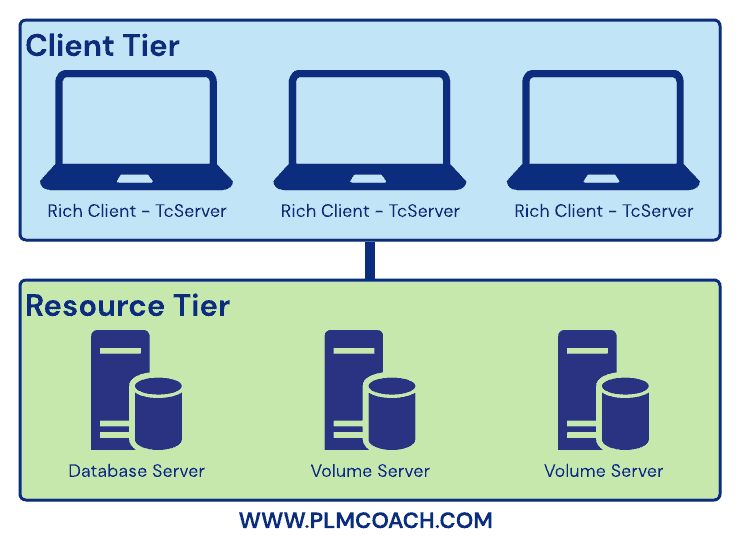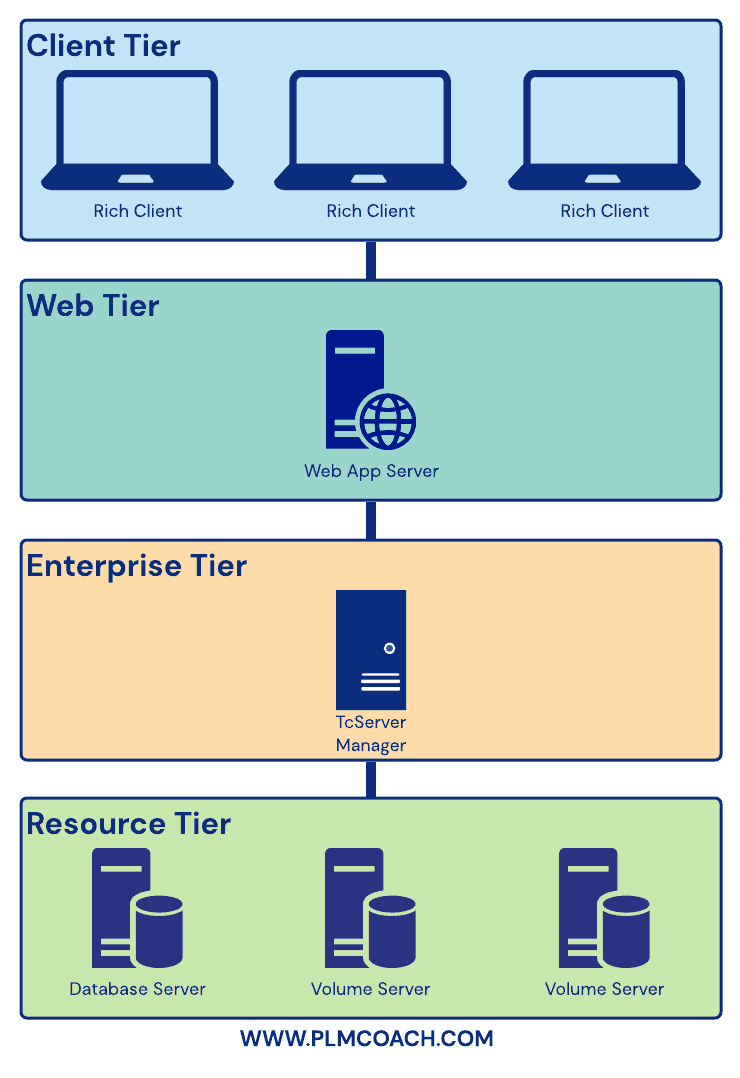 s Teamcenter PLM Architecture - 2 Tier - PLM Coach" width="739" height="560" />
s Teamcenter PLM Architecture - 2 Tier - PLM Coach" width="739" height="560" />Teamcenter software is a modern, adaptable product lifecycle management (PLM) system that connects people and processes, across functional silos, with a digital thread for innovation.
Rating: 4.98Teamcenter is a comprehensively used PLM solution. It is majorly used by manufacturing companies to help them delivering exceedingly complex products while maximizing productivity and streamlining global operations. Also, Teamcenter helps to increases revenue, and assist companies to market faster, reduce costs, and improve product quality.
There are two architectures that can be established for the site’s Teamcenter PLM environs. It can be set up in one of both within a single PLM surrounding.
The Client Tier contains:
Teamcenter manages the resource tier stores persistent metadata and files. The resource tier contains:
 s Teamcenter PLM Architecture - 2 Tier - PLM Coach" width="739" height="560" />
s Teamcenter PLM Architecture - 2 Tier - PLM Coach" width="739" height="560" />
The client tier hosts client application, secure file caches, and executes a user interface input and output.
The available client includes:
The web tier carries off client installs, deliver static content to clients, proceed client requests to business logic, executes login requests, and manages communication between the client and enterprise tiers. The Web tier application contains:
The enterprise tier serves business logic, retrieves data, and stores data in the database, process security rules, deliver dynamic content to clients. The enterprise tier contains:
Teamcenter handles the files and persistent metadata stored by the resource tier. The resource tier is comprised of:

The Teamcenter PLM Functional Training course presents the concepts of product lifecycle management (PLM). In this Teamcenter PLM Functional Training, students will get acquainted with the rich client user interface and get a hold of the basics of using Teamcenter PLM. Teamcenter PLM Functional Training gives instruction on working in the rich client interface and basics of Teamcenter PLM application, which covers My Teamcenter, embedded viewer, classification, Structure Manager, Change Manager, and Workflow Viewer.
Teamcenter PLM Deployment Training course presents the two-tier and four-tier architecture and exhibits how to install the components of this architecture. Teamcenter PLM Deployment Training covers two-tier rich clients, Business Modeler IDE, corporate server, Database server. Teamcenter PLM Deployment Training also covers installment and configuring Web application server, Server Manager, thin client, distribution server instance, distribution server, four-tier client, the embedded viewer, FSC cache server, NX integration, Store and Forward, Dispatcher, and creation of an additional site for Teamcenter PLM.
Teamcenter PLM Administration Training course serves the configuration of Teamcenter Administration Data by using the Rich Client to carry out the company’s requirements. Teamcenter PLM Administration course delivers a focused set of topics that directly address application administration. In the Teamcenter PLM Administration training course, you will get familiar with the fundamentals of how to handle and create administration data in Teamcenter PLM. Teamcenter PLM Administration Training Topics is also included in this course and it will include configuring and handling your company’s organization, Workflows, Stylesheets, Import, and Export Rules, commands, and how to migrate to additional sites or process report against that data.
Teamcenter PLM Business Modeler Administration (BMIDE) Training course enlightens about the configuration of the Teamcenter PLM data to go well with the company’s needs by using the Business Modeler IDE (BMIDE). Teamcenter PLM Business Modeler Administration (BMIDE) course put onwards a focused set of topics from the first half of the Application and Data Model Administration course which aligns perfectly with data model administration and developers. In Teamcenter PLM Business Modeler Administration (BMIDE) Training course, you will get to grasp the fundamentals of Business Modeler IDE (BMIDE), it also teaches about extending data model, and deployment techniques and the option for getting changes into your deployment, Quality Assurance (QA), and Production Sites. Content which has been included in Teamcenter PLM Business Modeler Administration (BMIDE) training is the introduction to the Business Modeler IDE (BMIDE) in Teamcenter PLM, the extension of the data model with new elements such as a business object, properties, Lists of Values (LOVs), Rules, and much more in Teamcenter PLM, deployment strategies and troubleshooting, preference and Teamcenter PLM utility reference.
Teamcenter PLM Server Side (ITK) Customization Training course teaches about customizing standalone ITK and SOA utilities, Teamcenter PLM Rich Clients, and the Teamcenter PLM server. In Teamcenter PLM Server Side (ITK) Customization training, candidates will be endowed with cutting-edge knowledge about Integrated Toolkit (ITK) and Service-Oriented Architecture (SOA)building, building standalone command line utilities to bring up custom code written in either ITL or SOA in Teamcenter PLM, and APIs in Teamcenter PLM.
Participants will be exposed to a thriving environment provided by Microsoft Visual Studio and Eclipse to grasp the debugging and execution of their utilities in Teamcenter PLM. The participant will also be provided with the knowledge of how to use ITK and SOA for the extension of server functionality by creating Operations Extensions (Workflow Handlers), service inside of the Business Modeler, Metamodel Operations, and various deployment methods to obtain their customization to clients/server in Teamcenter PLM. In short, Participants will imbibe how to create custom plugins using Eclipse to build custom interface components for the Rich Clients to bring up server-side code in Teamcenter PLM. Taking a plunge into Style Sheets to stir customization and to influence the data display in the clients will also be talked about.
Teamcenter PLM Client Side (RAC) Customization Training course teaches customization Teamcenter PLM Rich Clients using Java (SWT) and SOA. In the Teamcenter PLM Client Side (RAC) customization training course, you will get acquainted with how to work with a style sheet, and also learn modifying, creating, and registering Style Sheets to control the display of properties of Users. This method can brief about the user interface (UI), decreasing the number of clicks that it takes to perform Teamcenter PLM tasks.
Teamcenter PLM Active Workspace Customization and configuration course educate Active Workspace administrators and developers about how to customize and configure Active Workspace. Students will be displayed how to configure configuration of title for several scopes and make them learn to perform a variety of functionality in Teamcenter PLM. The review of the modified look and feel of the Teamcenter PLM client will take place, which includes custom themes, message notifications, icon configuration, CSS layout configuration. Teamcenter PLM Active Workspace Customization Training course will lay a strong emphasis on an in-depth look at the declarative approach for customization of the Active Workspace interface in Teamcenter PLM.
Students will get to work in the Teamcenter PLM Business Modeler IDE to control Index settings of data model objects and also the visibility of commands. In Teamcenter PLM Active Workspace (AWC) Customization course, candidates will try hands-on style sheet (XRT) improvements and capabilities utilizing custom tags and AnularJS and also work in thriving environs set up by Visual Studio code for easy debugging for Teamcenter PLM. Teamcenter PLM Active Workspace (AWC) Customization Training gives a summary of customizing the TcFTSIndexer to index additional object types, both internal and external, will also be included.
Checkout our Other Resources